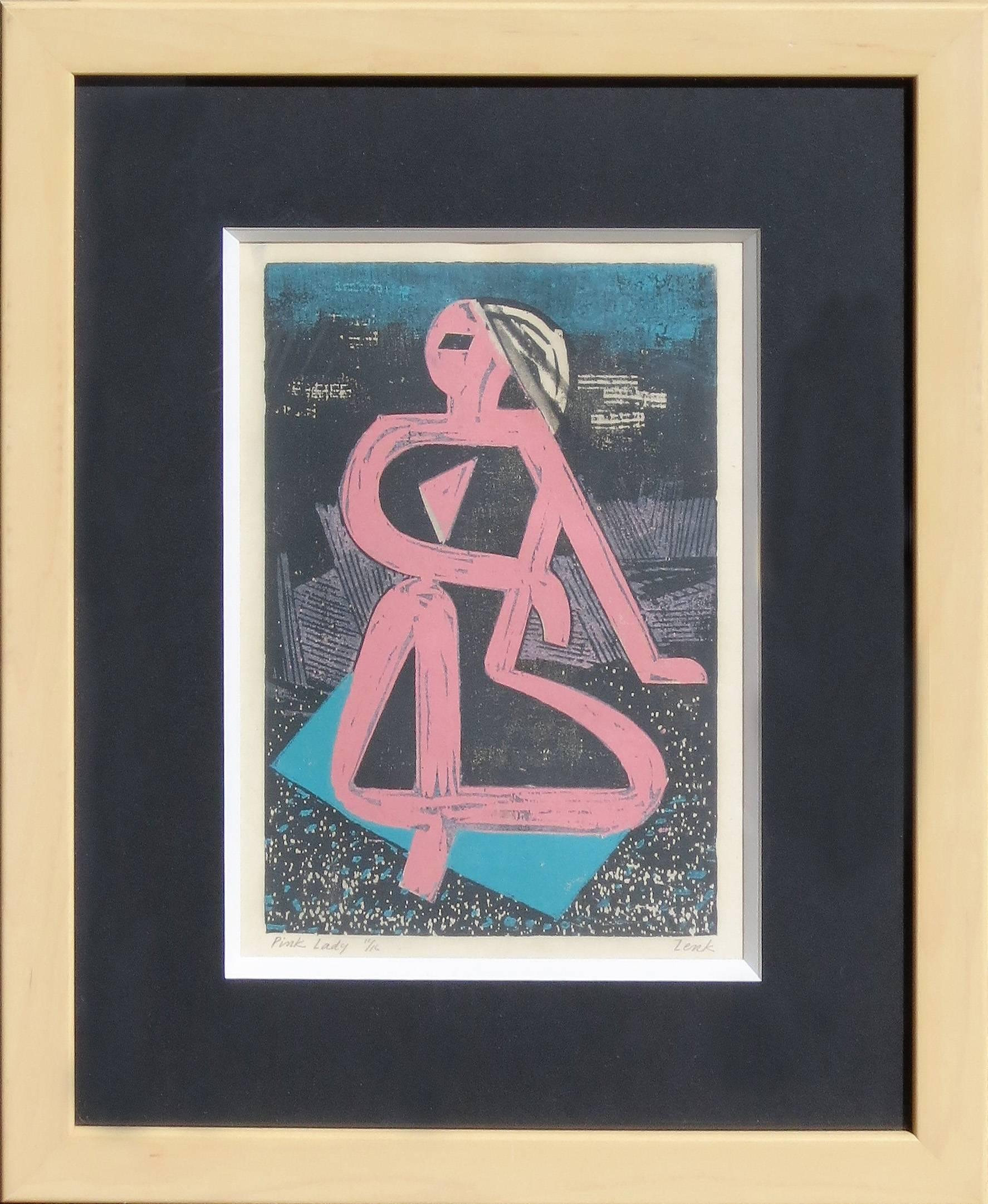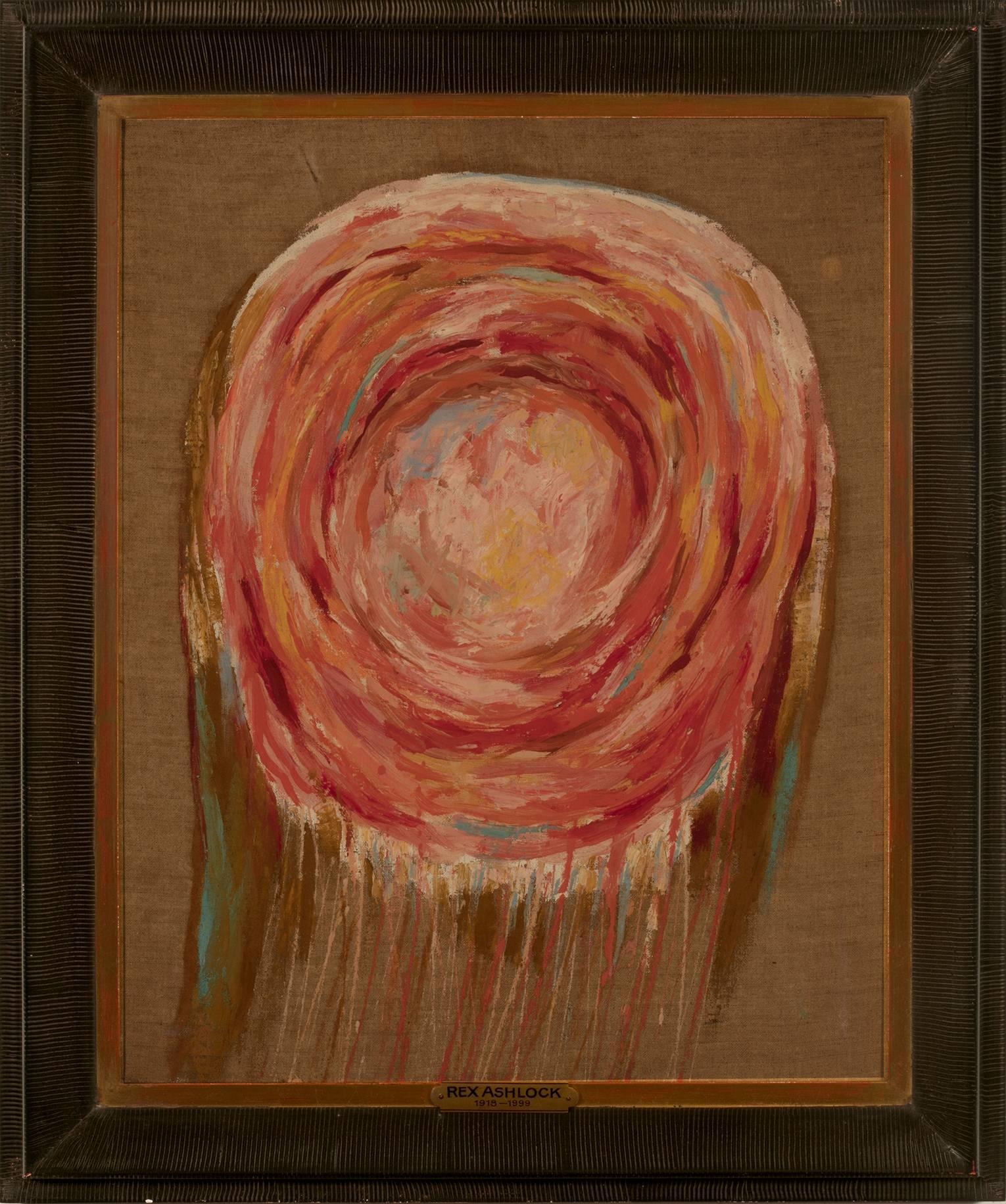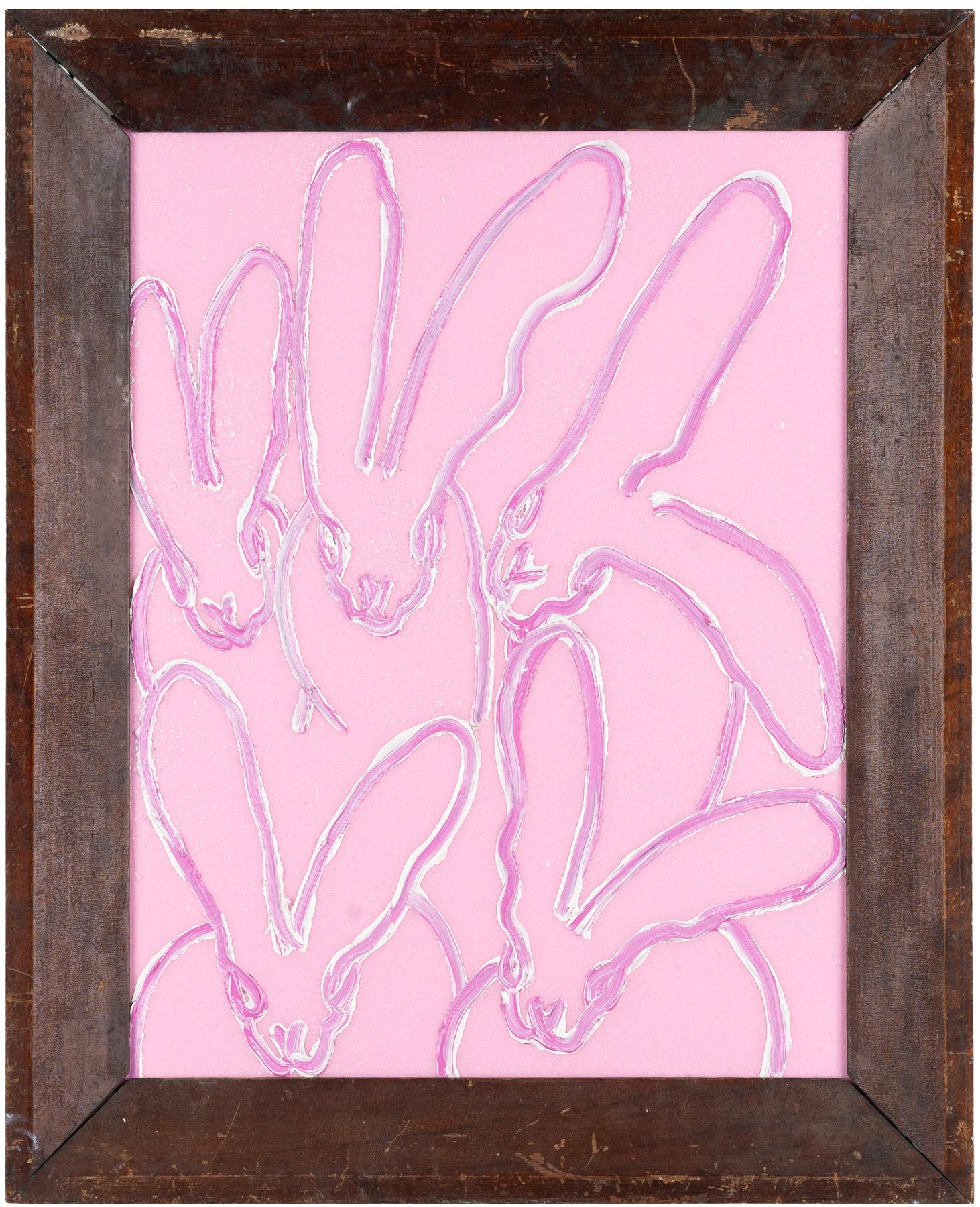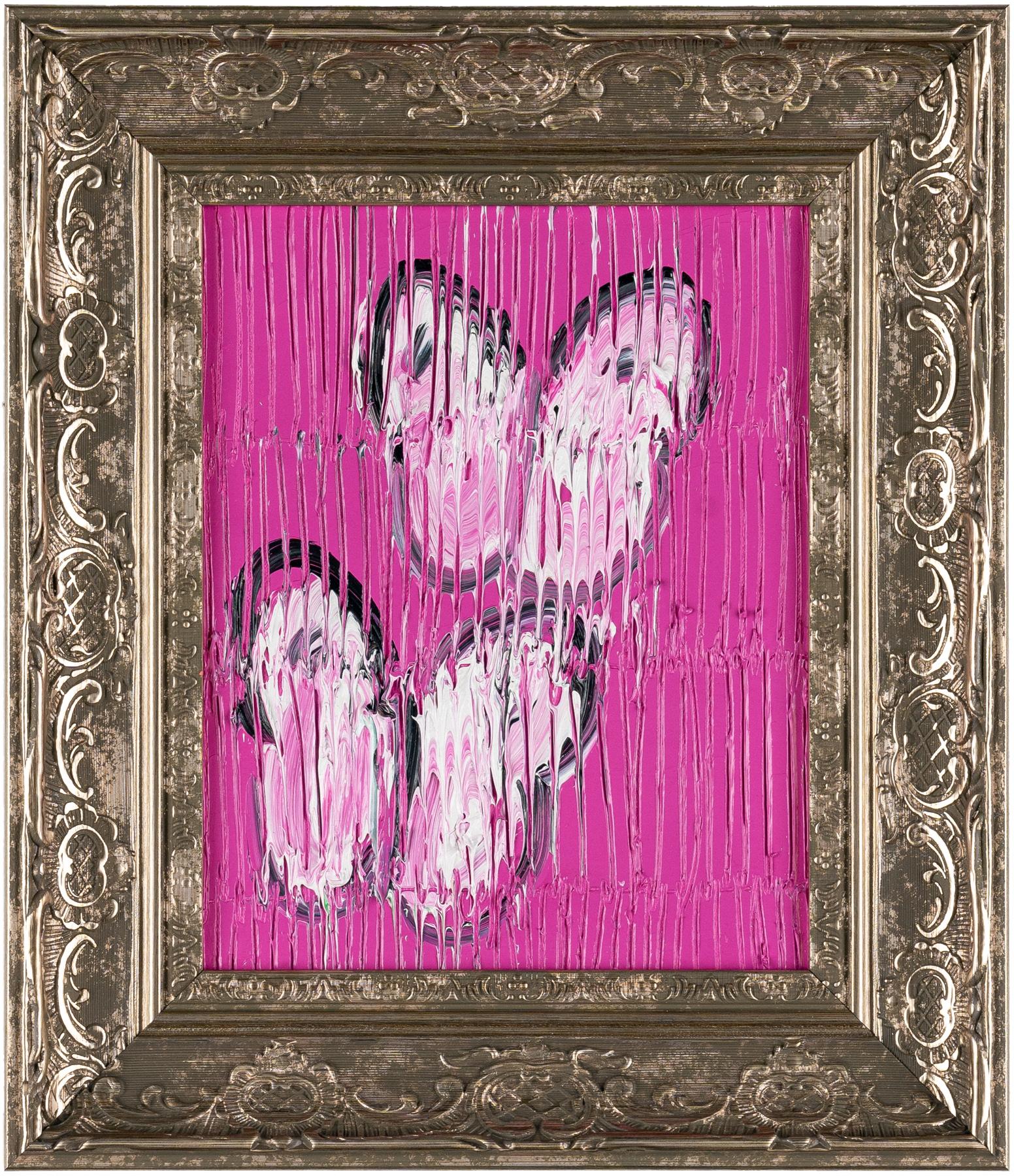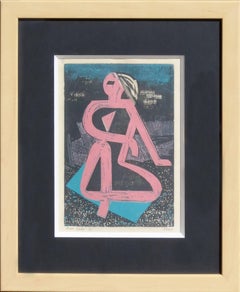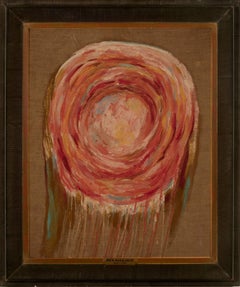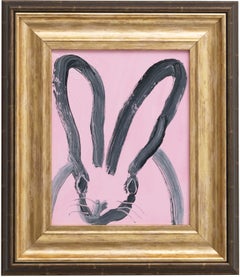Want more images or videos?
Request additional images or videos from the seller
1 of 11
Byron GalvesPink Lady1989
1989
$2,000
£1,508.20
€1,744.30
CA$2,805.99
A$3,119.03
CHF 1,634.93
MX$38,090.92
NOK 20,411.15
SEK 19,203.09
DKK 13,018.98
About the Item
THis artwork "Pink Lady" 1989, is an acrylograph on hand made paper by noted Mexican artist Byron Galves, 1941-2009. It is hand signed, dated and numbered 64/150 in white pencil by the artist.The artwork size is 28.5 x 15.5 inches, paper sheet size is 32 x 23.85 inches, framed size is 44 x 36 inches. Beautifully custom framed in a wooden silver frame, with dark purple backing and bevel. It is in excellent condition, the frame have some small minor restorations, barely visible.
About the artist:
Byron Gálvez (October 28, 1941 – October 27, 2009) was a Mexican artist who was primarily known for his painting but also created sculpture, including monumental works. He was born in rural Hidalgo state, to a father who played jazz music and read literature, a rarity in 1930s rural Mexico. However, it exposed Gálvez to culture, even though this led to an interest in visual art rather than musing or writing.
He went to Mexico City to study art at both the undergraduate and graduate level, but never completed his degrees, opting instead to begin career after his coursework. Before his first individual exhibition, his work was criticized by Justino Fernández, but all of the paintings were sold in advance to foreign buyers including American actor Vincent Price, who called Gálvez a “Mexican Picasso.” Gálvez then managed to replace the forty five paintings for the exhibition in a week. Since then he had individual and collective exhibitions in Mexico, the United States and other parts of the world. He concentrated on painting, which he is better known for, in the 1970s and 1980s, but moved on to sculpture, including monumental works later in his career. Recognitions for Gálvez's work include membership in the Salón de la Plástica Mexicana, a retrospective at the Palacio de Bellas Artes and two books published about his life.
Gálvez was born in Mixquiahuala, Hidalgo and described his childhood as happy, and would not have changed it. His father, Roberto Gálvez, was a farmer and merchant, who was a music and literature enthusiast, a rarity is 1930s rural Mexico. His father played the violin in the town's jazz band, which had almost all classical instruments, making it similar to bands in New Orleans. They even composed new pieces. The artist was named after Lord Byron, and his brothers, Eliot, Aníbal and Dante, after his father's reading preferences
This meant that Gálvez grew up in an environment that encouraged the enjoyment of the arts. However, instead of music or literature, Gálvez stated that his earliest memories related to his attraction to art and that he always wanted to be a painter. The difficulties of farm life convinced him that he needed an education and would have to move to Mexico City in order to go to school. At age sixteen he left home for the capital to study painting at the Escuela Nacional de Artes Plásticas, not knowing what the study would entail. It was far more rigorous than he expected, with thirteen-hour school days leaving only weekends to earn money to live on.[3] He did his undergraduate studies from 1958 to 1962, then continued with the graduate courses from 1962 to 1964, specializing in painting.
He did much of his studies under teachers such as Luis Nishizawa, Fernando Castro Pacheco, Francisco Moreno Capdevila, Santos Balmori, Antonio Rodríguez Luna and Antonio Ramírez. The last teacher taught him to love his studies above all else and he submitted himself to the academic rigor. This led him to become attracted to the Cubism of Picasso, and felt that the artist has opened roads which could be taken and widened. Although he specialized in painting, his interest in sculpture was also evident at this time as he was a founding member of a metal sculpture workshop at the institution along with Armando Ortega and Baltazar Martinez.[2][5] Although he completed his coursework, he did not finish the other requirements needed for the degree, instead opting to start his career.
Gálvez married once to art dealer Eva Beloglovsky.The couple first met in 1973, but did not meet again until two years later, when Beloglovsky bought one of his paintings and sold two more through her art gallery. At first it was a working relationship, and then evolved into a romantic one. During their marriage, they worked on a number of projects together such as multi-media presentations and charity benefits. The couple remained together until Galvez's death.
Although he began and developed much of his career in Mexico City, in his later life, the artist moved back to his rural hometown. Gálvez constructed a house and studio on the edge of a ravine in which flows the Moctezuma River. The structure has glass walls positioned for maximum light and a privileged view of a local landmark, a hill called El Elefante.
Gálvez's work included painting, sculpture, etching, lithography, and drawing.[4] For Galvez, art was spiritual and disconnected with physical logic, when only aesthetics mattered. Female figures are common, and often are sensual. He work has been influenced by the Cubism of Picasso and Georges Braque, by African and Oceanic folk art and by pre-Columbian sculpture. He preferred large scale works often bigger than seven by seven feet. He painted while listening to classical, jazz and occasionally, rock music.
Galvez's work experienced periods in which different artistic currents dominated including expressionism, abstract art and mixtures of the two. In his work, he tried to achieve a balance between figurative and abstract expression. The first stage of his painting was figurative expressionism, then abstract expressionism, under strong influence of Carlos Mérida, Rufino Tamaho, Santos Balmori, Kandinsky, Wifredo Lam and Picasso, along with some from classical painters such as Rembrandt and Caravaggio. Then for some time, he practiced abstract art, but then felt the need to draw human bodies again, especially female ones because he felt it allowed him better expression. Around 1980, he moved on to geometric figurativism, marked by the “Woman” exhibit at the Museum of Modern Art. This has also been describes as “pure chromatic constructivism. He considered himself primarily a sculptor and painted in that fashion. The work of Byron Galves is held in numerous corporate and private collections
Galvez died at age 67 at Inglés Observatorio Hospital from a heart attack. His ashes were deposited a year after his death to the side of one of the sculptures at his home in Mixquiahuala.
During his career, he exhibited individually and collectively in over sixty venues in Mexico, various cities in the United States, Europe and Latin America. In 1964, he had his first individual exhibition at the ENAP Gallery, after showing in collective exhibitions at the Palacio de Bellas Artes and private galleries along with more prominent painters such as José Chávez Morado, Alfredo Zalce, José Clemente Orozco, Diego Rivera, Carlos Orozco Romero and David Alfaro Siqueiros. Before the opening of this exhibit, his work was severely criticized by art historian Justino Fernández. Despite this, the paintings for the exhibit were bought in advance, most by American actor Vincent Price, who called Gálvez a “Mexican Picasso.” The paintings were taken out of the country one week before the exhibit, but Gálvez was not concerned about not having paintings for the show, rather he was satisfied about his work being recognized and supported.He managed to create forty five more paintings in the remaining time in order to have the exhibit. After this individual exhibit, Gálvez had over 55 more over he career, along with participated in other 75 collective exhibits. Important exhibits include the Solar 68 collective exhibition at the Palacio de Bellas Artes (1968), the Sterenberg Galleries, Chicago (1972), Eye Corporation in various US cities (1973), Polyforum Cultural Siqueiros (1978), Museo de Arte Moderno in Mexico City (1982), Harcourts Contemporary Gallery in San Francisco (1983, 1990), Art-Forum Gallery in Mexico City (1984), Bishop Gallery in Phoenix (1989), Merryl Chase Gallery in Washington, DC (1991, 1992), Suhan Galleries in San Diego (1992), Misrachi Gallery (1994) and San Francisco Theater in Pachuca (1995) .[4][2] After his death, the Secretaría de Relaciones Exteriores sponsored an exhibition of his work in Tainan, Taiwan in 2011. His works can be found in major collections in both Mexico and the United States. The strongest demand has been for his figurative work especially that produced later in his life. Gálvez also created murals and sculptures, both small and monumental. His first mural was sculpted done in 1968 in Los Angeles. However, most of his monumental work was produced later in his career as he concentrated on painting in the 1970s and 1980s. These include a mural at the National Conservatory of Music in Mexico City (1970), a thirty-foot high sculpture in Unidad Morelos in Mexico City (1971), a hand hammered copper triptych for a private residence in Mexico City (1984), a sculpted door for a private residence (1985), a sculpture for a private home in New York (1986), Reclined Torso at the Hotel Nikko Mexico (1998), Torso I a five-foot high sculpture for the city of Pachuca (1999), Torso II a nineteen foot high sculpture at the Altiva Building, Mexico City (1999), Millenium, a bronze sculpture/fountain at the highway entrance to Pachuca (2000), a sculpture garden for Mixquiahuala, Hidalgo (2005) and the master plan and central mosaic for the David Ben Gurion Cultural Park in Pachuca (2007). The park project, the last before his death, included not only the creation of the central mosaic, the largest pedestrian mural in the world at 345,000f, but also the design of the 65-acre park itself. His other activities included the teaching of drawing at his alma mater, the creation of a program for the radio ministry of Mexico in 1973, participation in a documentary about lithography in Mexico in 1980 and the creation of several special programs for the office Radio, Television and Cinematography. In 1995, he was appointed as a member of the Consejo Nacional de Arte y Cultura of the state of Hidalgo. In 1997, he participated in a cultural exchange with the Valparaíso Foundation of Spain. Galvez received over fifteen awards and honorary tributes during his lifetime. Recognitions for his work include first prize in sculpture in a competition organized by the Ford company in 1966, first prize in sculpture from the Instituto Nacional de Juventud in 1967, honorable mention from a contest promoted by the Comisión Federal de Acero in Mexico City (1971) and first place at the Salon Annual de la Plástica Mexicana in Mexico City in 1972, 1975 and 1986. In 1968, he became a member of the Salón de la Plástica Mexicana. In 1996, the Palacio de Bellas Artes held a retrospective called Semblanza de 30 años. Two books published about his life in 1982 and 1997. After his death, his hometown named their cultural center after him, and he was awarded a merit medal posthumously by the governor of the state.
- Creator:Byron Galves (1941 - 2009, Mexican)
- Creation Year:1989
- Dimensions:Height: 44 in (111.76 cm)Width: 36 in (91.44 cm)Depth: 1.5 in (3.81 cm)
- Movement & Style:
- Period:
- Condition:
- Gallery Location:San Francisco, CA
- Reference Number:Seller: gal/pin/wom/011stDibs: LU666315796312
About the Seller
5.0
Platinum Seller
Premium sellers with a 4.7+ rating and 24-hour response times
Established in 1999
1stDibs seller since 2017
829 sales on 1stDibs
Typical response time: 1 hour
- ShippingRetrieving quote...Shipping from: San Francisco, CA
- Return Policy
Authenticity Guarantee
In the unlikely event there’s an issue with an item’s authenticity, contact us within 1 year for a full refund. DetailsMoney-Back Guarantee
If your item is not as described, is damaged in transit, or does not arrive, contact us within 7 days for a full refund. Details24-Hour Cancellation
You have a 24-hour grace period in which to reconsider your purchase, with no questions asked.Vetted Professional Sellers
Our world-class sellers must adhere to strict standards for service and quality, maintaining the integrity of our listings.Price-Match Guarantee
If you find that a seller listed the same item for a lower price elsewhere, we’ll match it.Trusted Global Delivery
Our best-in-class carrier network provides specialized shipping options worldwide, including custom delivery.More From This Seller
View AllUntitled
By Terry Leftrook
Located in San Francisco, CA
This artwork "Untitled" c.1980 is an original offset lithograph on wove paper by Canadian artist Terry Leftrook, born 1948. It is hand signed in pencil by the artist, also inscribed...
Category
Late 20th Century Modern Abstract Prints
Materials
Offset
Untitled
By Terry Leftrook
Located in San Francisco, CA
This artwork "Untitled #5" c.1980 is an original offset lithograph on wove paper by Canadian artist Terry Leftrook, born 1948. It is hand signed in pencil by the artist. The artwork...
Category
Late 20th Century Modern Abstract Prints
Materials
Offset
Untitled
By Terry Leftrook
Located in San Francisco, CA
This artwork "Untitled" 1987 is an original offset lithograph, with pastel addition on wove paper, by Canadian artist Terry Leftrook, born 1948. It is unsigned. The size is 24.85 x ...
Category
Late 20th Century Modern Abstract Prints
Materials
Mixed Media
Femme en Rose Avec un Arbre
By André Brasilier
Located in San Francisco, CA
Artist: Andre Brasilier (French, born 1929)
Title: Femme en Rose Avec un Arbre
Year: c.1975
Medium: Color lithograph
Edition: Inscribed "Bien Amicalement" (With Friendship) in pe...
Category
Late 20th Century Expressionist Figurative Prints
Materials
Lithograph
Untitled
By Richard Royce
Located in San Francisco, CA
This artwork "Untitled" c.1990 is a cast paper bas relief by noted American artist Richard Benjamin Royce, born 1941. It is signed at the lower right ...
Category
Late 20th Century Abstract Mixed Media
Materials
Paper
Tweet
Located in San Francisco, CA
This artwork titled "Tweet" c.1990, is an acrylic painting on paper by noted American artist Glen Chesnut. It is. signed and titled at the lower right corner by the artist. The artwo...
Category
Late 20th Century Abstract Abstract Paintings
Materials
Acrylic
You May Also Like
"Pink Lady"
By Josef Zenk
Located in Lambertville, NJ
Signed Lower Right
Titled and Numbered Lower Left
Josef Zenk (1904-2000)
Josef Zenk was born in New York City in 1904. After graduating from high school he studied for three years...
Category
20th Century Abstract Figurative Prints
Materials
Paper, Color
$7,000
"Pink"
By Rex Ashlock
Located in Lambertville, NJ
Jim’s of Lambertville is proud to offer this artwork by:
Rex Ashlock (1918 - 1999)
Born in Spokane, WA on Aug. 23, 1918. Ashlock moved to San Francisco in 1937 and was a copy boy...
Category
1960s Abstract Abstract Paintings
Materials
Canvas, Oil
$11,200
Nude in Pink
Located in Houston, TX
Elegant pencil and pastel nude female in pink, circa 1990.
Original artwork on paper displayed on a white mat with a gold border. Archival plastic sleeve and ...
Category
1990s Nude Drawings and Watercolors
Materials
Pastel, Pencil
Hunt Slonem "Pink Passion" Bunny
By Hunt Slonem
Located in Boston, MA
Artist: Slonem, Hunt
Title: Pink Passion
Date: 2025
Medium: Oil on wood
Unframed Dimensions: 10" x 8"
Framed Dimensions: approximately 16.5" x 14.5"
Signature: Signed by Artis...
Category
2010s Contemporary Paintings
Materials
Oil
Hunt Slonem "Pink Diamonds" Bunnies
By Hunt Slonem
Located in Boston, MA
Artist: Slonem, Hunt
Title: Pink Diamonds
Date: 2024
Medium: Oil & Acrylic w/ Diamond Dust on Wood
Unframed Dimensions: 20" x 15.5"
Framed Dimensions: 24" x 19.5"
Signature: Si...
Category
2010s Contemporary Paintings
Materials
Acrylic, Mixed Media, Oil
Hunt Slonem "Magenta" Butterflies
By Hunt Slonem
Located in Boston, MA
Artist: Slonem, Hunt
Title: Magenta
Date: 2024
Medium: Oil on Wood
Unframed Dimensions: 10" x 8"
Framed Dimensions: 14.5" x 12.5"
Signature: Signed Verso
Edition: Unique
Prove...
Category
2010s Contemporary Paintings
Materials
Oil
More Ways To Browse
Bronze Nude Woman
Black Bronze Nudes
Lady Dior In Black
Dior Pink White
Farmer Sculpture
Fountain Woman
Vintage Hotel Doors
1930s Vintage Radio
Vintage Glass Eye Studio
Dior 1998 Fashion
Santos Art Sculptures
Mexican Santos
1970 Copper Wall Art
1930s Recliner
Vintage Doors Los Angeles
Violin Instrument
Metal Wall Sculptures 1980s
1980s Recliner
